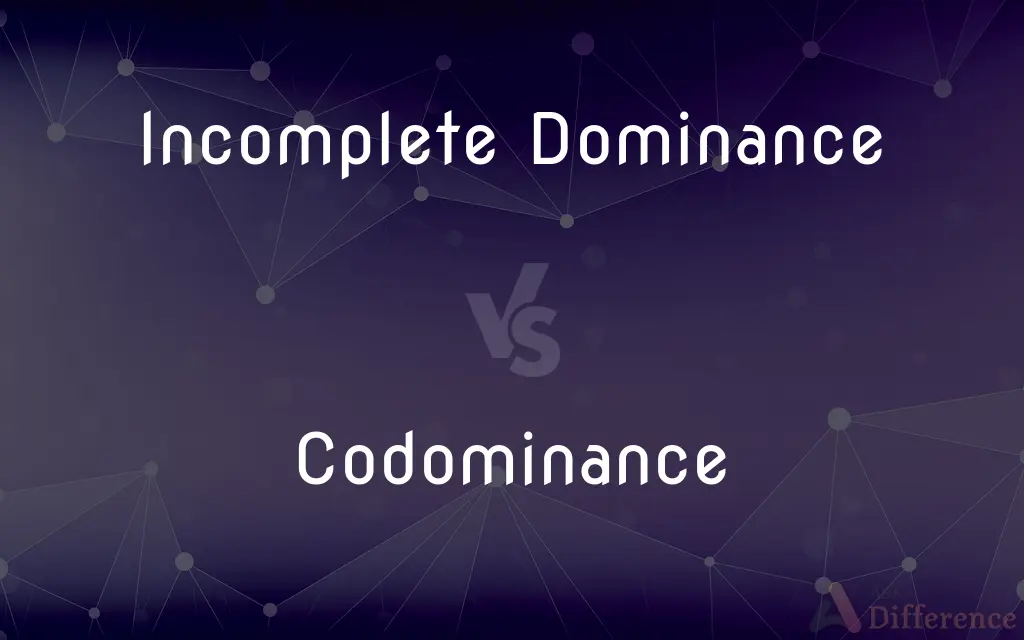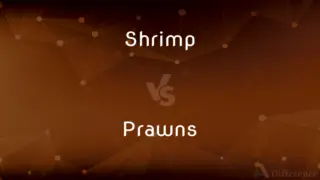Incomplete Dominance vs. Codominance — What's the Difference?
Edited by Tayyaba Rehman — By Fiza Rafique — Published on December 2, 2023
Incomplete Dominance involves blending of traits; Codominance displays both traits distinctly.

Difference Between Incomplete Dominance and Codominance
Table of Contents
ADVERTISEMENT
Key Differences
In the realm of genetics, Incomplete Dominance refers to the blending of two parental traits, producing an intermediate offspring phenotype. Conversely, Codominance refers to the scenario where both parental traits appear distinctly in the offspring without blending.
When Incomplete Dominance is at play, neither allele for a specific trait fully dominates the other. Hence, neither trait is fully expressed. Codominance, on the other hand, ensures that both alleles for a trait are fully expressed, leading to a phenotype where both traits are visible.
An often-cited example for Incomplete Dominance is the crossbreeding of a red-flowered and white-flowered plant, resulting in pink-flowered offspring. In terms of Codominance, crossing a black chicken with a white one could produce a checkered-pattern offspring, where both colors distinctly appear.
Incomplete Dominance essentially creates a middle-ground phenotype, a blend or mixture of both parental traits. Meanwhile, Codominance allows both parental traits to stand out, unblended and distinctly identifiable in the offspring.
Understanding the distinction between Incomplete Dominance and Codominance is crucial in genetics. While both concern the expression of traits from different alleles, Incomplete Dominance merges these traits, whereas Codominance preserves their individuality.
ADVERTISEMENT
Comparison Chart
Trait Expression
Blended
Distinct and unblended
Resulting Phenotype
Intermediate of two traits
Displays both traits
Example
Pink flowers from red and white parents
Checkered chickens from black and white parents
Allele Behavior
Neither dominates
Both are fully expressed
Visual Representation
Middle ground between traits
Both traits visible side by side
Compare with Definitions
Incomplete Dominance
Produces an intermediate phenotype.
The concept of Incomplete Dominance explains the appearance of unexpected intermediate phenotypes.
Codominance
Neither allele masks the other.
In Codominance, both alleles contribute equally to the phenotype.
Incomplete Dominance
Blending of two distinct traits.
When a red and white flower breed, Incomplete Dominance produces pink flowers.
Codominance
Produces offspring displaying both parental traits.
Codominance ensures that neither parent's trait gets overshadowed in the offspring.
Incomplete Dominance
Neither allele is dominant over the other.
Due to Incomplete Dominance, neither the red nor the white trait fully prevails.
Codominance
Each allele is equally dominant.
Thanks to Codominance, no trait gets subdued or masked by the other.
Incomplete Dominance
Doesn't fully express either allele.
Because of Incomplete Dominance, both original traits get diluted in the offspring.
Codominance
Distinct, unblended representation of traits.
Codominance retains the integrity of both original traits without blending.
Incomplete Dominance
Parental traits merge in offspring.
Incomplete Dominance ensures that offspring traits are a mix of both parents.
Codominance
Both traits from parents are fully expressed.
Due to Codominance, a cross between a black and white chicken can result in a checkered offspring.
Codominance
A heterozygous condition in which both alleles at a gene locus are fully expressed in the phenotype.
Codominance
(genetics) A condition in which both alleles of a gene pair in a heterozygote are fully expressed, with neither one being dominant or recessive to the other.
Common Curiosities
In Codominance, do the traits get mixed?
No, both traits from the parents are expressed without mixing.
Is one allele dominant in Incomplete Dominance?
No, neither allele is dominant, leading to a blend of traits.
Can you provide an example of Incomplete Dominance?
Yes, when a red-flowered plant and a white-flowered plant produce pink-flowered offspring.
How is the phenotype affected by Incomplete Dominance?
The resulting phenotype is an intermediate or blend of the two parental traits.
Is the pink flower in Incomplete Dominance a new trait?
It's an intermediate phenotype resulting from the blending of red and white traits.
How does Codominance display in offspring?
Codominance displays both parent traits distinctly without blending.
What is the main difference between Incomplete Dominance and Codominance?
Incomplete Dominance involves blending of traits while Codominance shows both traits distinctly.
Can you give an animal example for Codominance?
Yes, when a black chicken and a white chicken produce offspring with a checkered pattern.
Do both parental traits appear in Codominance?
Yes, both traits appear side by side without blending.
Are the traits in Codominance considered dominant or recessive?
Both traits are considered equally dominant, and both are expressed.
In genetics, which concept leads to a middle-ground phenotype?
Incomplete Dominance leads to a middle-ground phenotype.
Does Incomplete Dominance lead to a third phenotype?
Yes, it leads to an intermediate phenotype, different from both parents.
Why don't we see blending in Codominance?
Because both alleles are fully and equally expressed, retaining their distinct appearances.
Can Incomplete Dominance and Codominance occur for the same trait?
Not for the same trait in the same organism, as they are two distinct genetic mechanisms.
Which concept, Incomplete Dominance or Codominance, displays a more clear distinction of parental traits?
Codominance displays a clear distinction of parental traits without blending.
Share Your Discovery

Previous Comparison
Shrimp vs. Prawns
Next Comparison
Bose Companion 2 vs. Creative T40Author Spotlight
Written by
Fiza RafiqueFiza Rafique is a skilled content writer at AskDifference.com, where she meticulously refines and enhances written pieces. Drawing from her vast editorial expertise, Fiza ensures clarity, accuracy, and precision in every article. Passionate about language, she continually seeks to elevate the quality of content for readers worldwide.
Edited by
Tayyaba RehmanTayyaba Rehman is a distinguished writer, currently serving as a primary contributor to askdifference.com. As a researcher in semantics and etymology, Tayyaba's passion for the complexity of languages and their distinctions has found a perfect home on the platform. Tayyaba delves into the intricacies of language, distinguishing between commonly confused words and phrases, thereby providing clarity for readers worldwide.
















































